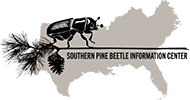Abstract
Bark beetles exposed to vapours of terpene hydrocarbons produce alcohols and ketones, apparently by oxidation at allylic positions. The predictability of such oxidations has now been extended to include non-terpenoid hydrocarbons. Exposure of Dendroctonus frontalis to 1-methyl l-cyclohexene resulted in the production of seudenol (3-methyl-2-cyclohexen-l-ol), a pheromone of D. pseudotsugae, along with the corresponding ketone and other alcohols. The most abundant of these was identified as 1-cyclohexenemethanol. A rearrangement product of seudenol, also believed to be present in D. pseudotsugae hindguts, was identified as 1-methyl-2-cyclohexen-l-ol. A similar rearrangement was detected upon exposure of D. frontalis females to ~-pinene. In addition to cis– and trans-verbenol, cis-3-pinen-2-ol was found in the hindguts. A general mechanism of oxidation and rearrangement is suggested, as further exemplified by the production of trans-pinocarveol and myrtenol by beetles exposed to β-pinene.
